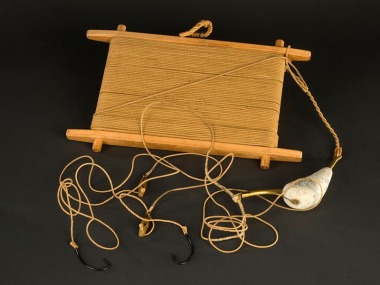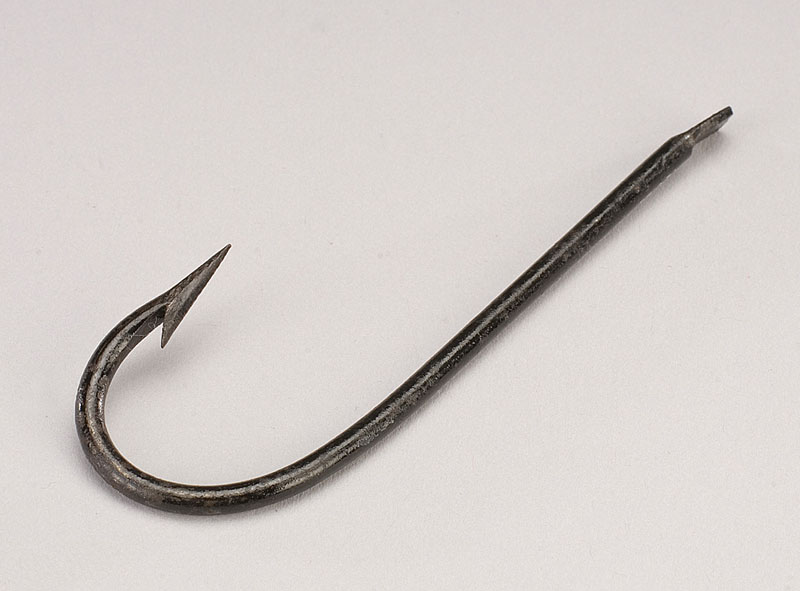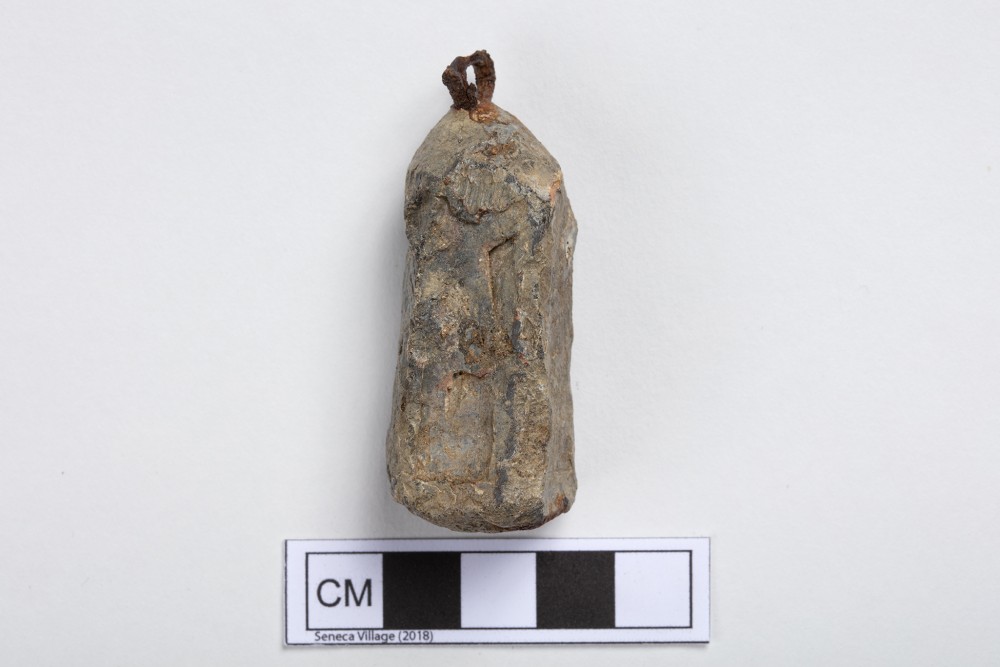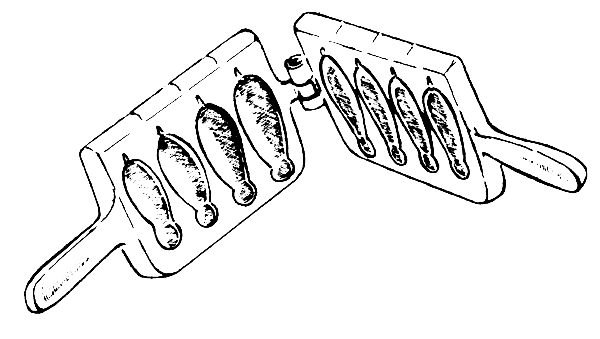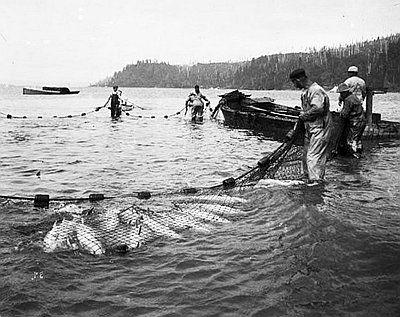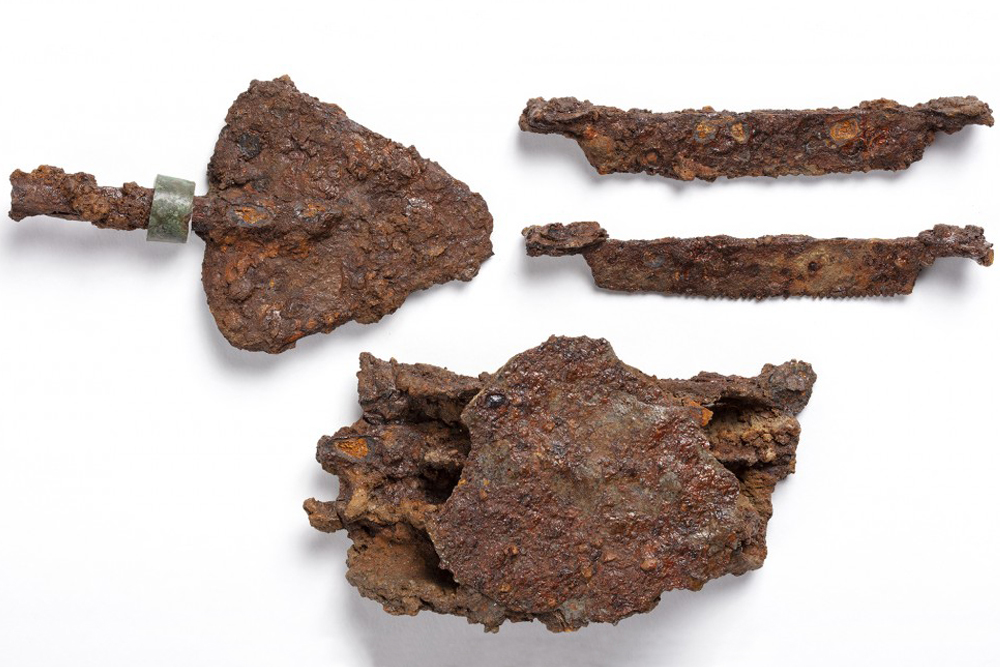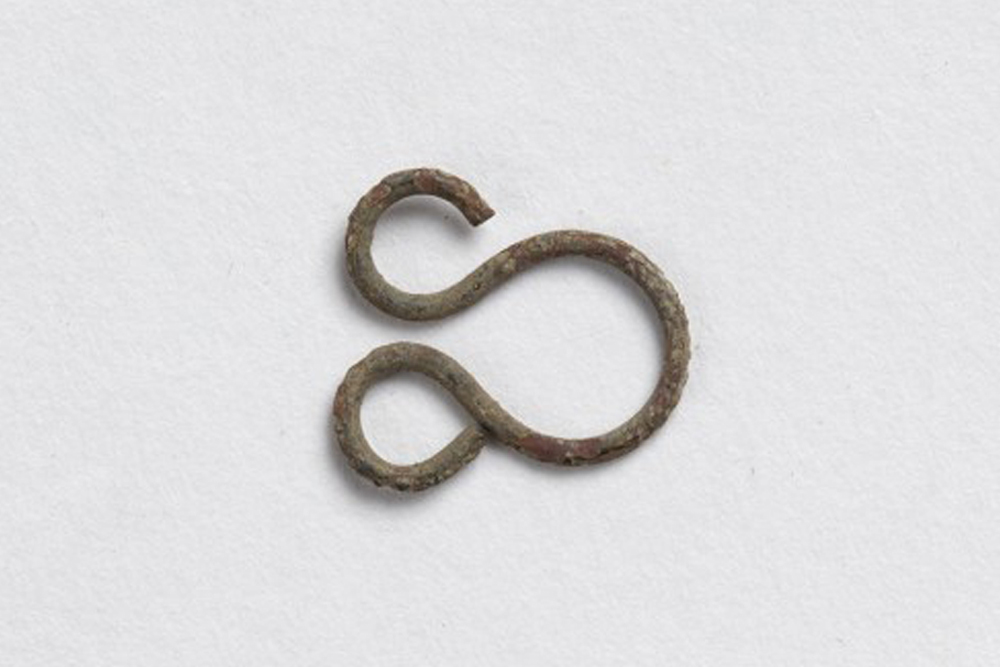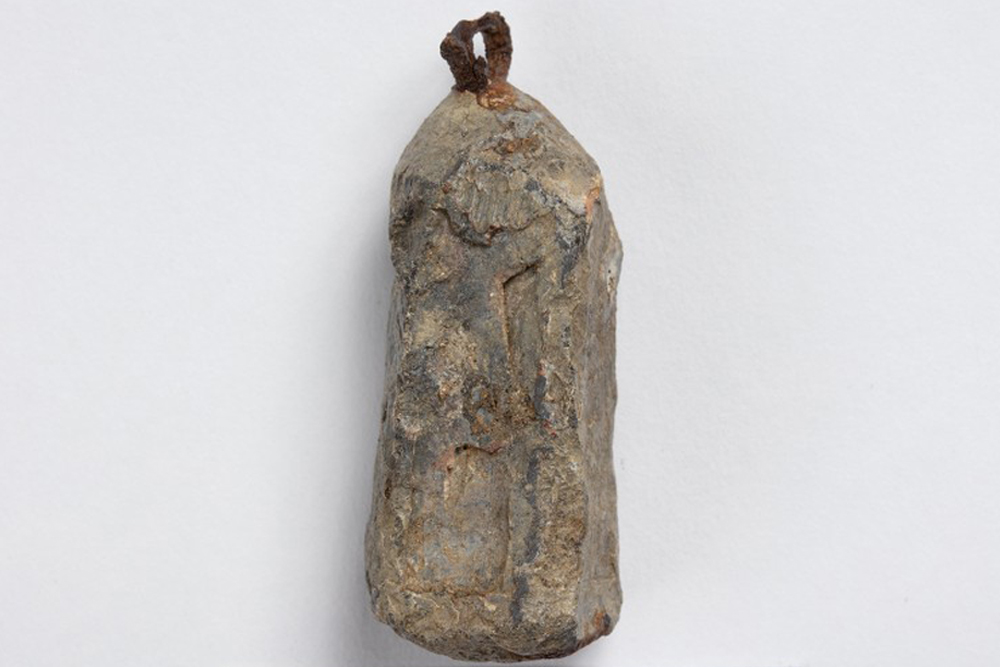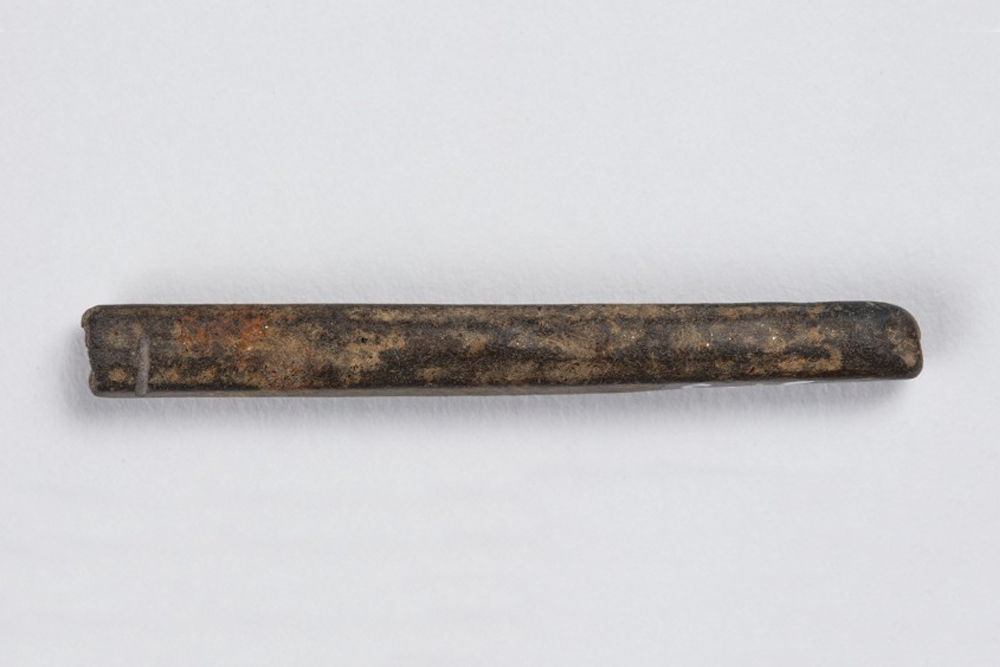Fishing weight
Buried within the ruins of the house of one Seneca Village resident, William Godfrey Wilson, was a lead weight similar in appearance to those used for centuries to fish (Harper 2010, 41). The material and composition of this weight was common, and similar items were found wherever anyone fished in the New World (Bjarnason 1992; Harper 2010, 42). Lead was an ideal metal because it did not corrode in water, was cheaper than alternative metals, denser than most rocks and stones, and could be easily molded into the desired shape using tools such as the one in Figure 5 (Scheuhammer et al. 2003). These weights were easy to acquire and proved necessary to successful handline fishing (Figure 1) (Bjarnason 1992). Different lead sinkers were used with nets (such as the seines shown in Figure 6) and metal hooks (Figure 2) were universal to all forms of fishing.
Global View of Fishing
Humans have practiced fishing since well before the earliest known human settlements (Rincon 2006). Fishing was an easy way to supplement an agricultural society because of how little one needed to get started; a line, some bait, weights, and the hooks provided the bulk of the equipment (Bjarnason 1992). Spears and nets diversified one’s methods of fishing and allowed for catching different types of fish, such as shellfish (Price 1966, 1375).
In the Americas
Weights, along with other fishing tools and techniques, became fairly commonplace in all societies where many families fished to supplement their diet. When European manufacturers saw the demand in the Americas, they flooded markets with cheap tools. Some communities even considered ‘fisherman’ a class in itself (Price 1966, 1368). In some Caribbean cultures, fishing was a lifestyle, and fishermen were given tremendous respect and admiration. In the United States, free Black fishermen were able to carve out a productive and independent niche with relative freedom and opportunities for business ownership (Price 1966, 1376).
While professional fishermen were a staple of the Black community, some of these skills were also passed on to the typical layman. Regardless of one’s work, it is likely that he would also fish. Fishing became an incredibly important facet of many families’ work after emancipation (Giltner 2008, 10). Fishing was not only a form of relaxation, but provided a sustainable food source for Black people shut out from most booming job markets (Berlin, Ira, and Leslie M. Harris. 2005, 20).
Black Fishermen in the Early US and NYC
Professional fishing was incredibly attractive for newly free Black men everywhere (Price 1966, 1376). Fishing was productive, free of white oversight, and ingrained in the culture. However, its rising popularity and increasing participation attracted serious attention and hatred from whites who made it their mission to disrupt and end Black autonomy and independence (Giltner 2008, 141).
These whites determined that Black fishermens’ self-subsistence enabled them to avoid partaking in agricultural labor and encroached on the rights of white fishermen by taking resources away from them (Giltner 2008, 139). Legislatures in fishing communities (particularly in the south) passed laws making fishing particularly difficult for Black men, and reduced their ability to thrive on fishing alone (Giltner 2008, 139).
When slavery ended and Blacks and whites competed for the same jobs, Blacks were systematically cut out of fishing and many other jobs through laws and hiring discrimination (Berlin and Harris 2005, 20). Job discrimination was a major factor in the life of Seneca Villagers who recognized the job competition downtown, and the benefits of self-sufficiency uptown.
Although fishing is usually associated with southern Blacks (Fiege 2012, 322), New York City was a fishing hub since the Dutch first arrived (Gill 2012, 20). Developing Black communities in Manhattan, Brooklyn, and New Jersey embraced fishing both as work and identity (Gall 2017, 207).
Relation to Seneca Village
The growing Black community in Seneca Village was no exception. While we know that fishing was commonplace among free Black men, it is unlikely that William was the one fishing because he appears to have been too busy: the census shows him working as a porter, while the All Angels Church records indicate he was also the church’s sexton. The censuses also show that he had young boys in the house (NYSC 1855)–in 1855, William had six boys. The second and third oldest, Joseph (15) and John (13), were too young to work, but certainly old enough to help out the family. Seneca Villagers were considered to be part of a Black middle class in Manhattan. They prioritized education for their families and valued hard work. The girls likely helped their mother with domestic chores, while the boys could have contributed through fishing and other means (Wall et al. 2018, 66). It was likely that the boys went to the East River or the Hudson River, though there were many places throughout the city where one could fish (Rosenzweig et al. 1992, 70).
Closing
Everyone in Seneca Village contributed to their family and community with some form of work. For some of the children, it was getting an education. For William Wilson, it was his jobs as a sexton and porter. It makes sense that his young sons would help provide food for the family before they were fully involved in the labor force. Using a weight (Figures 3 & 4), some line, some bait, and a hook, the Wilson boys provided food for their family, and this enabled them to pursue other work, education, or chores that fell in line with the values of Seneca Villagers.
Works Cited
Berlin, Ira, and Leslie M. Harris. 2005. “Uncovering, Discovering, and Recovering: Digging in New York’s Slave Burial Past Beyond the African Burial Ground.” In Slavery in New York, edited by Ira Berlin and Leslie M. Harris. New York, NY: The New Press and the New-York Historical Society, 1-28.
Bjarnason, B.A. 1992. “Handlining and Squid Jigging.” Rome, Italy: Food and Agriculture Organization of the United Nations. http://www.fao.org/3/t0511e/T0511E00.htm
Erickson, Mark St. John. 3 Feb 2018. “Gateway to Freedom: Black Watermen Chart Course for Success on Hampton Roads Waterways.” Dailypress.com. www.dailypress.com/history/dp-nws-black-watermen-20180130-story.html.
Fiege, Mark. 2012. The Republic of Nature: An Environmental History of the United States. Seattle, WA: University of Washington Press.
Gall, Michael J., Richard F. Veit, Christopher Barton, et al. 2017. “African American Cultures and Place in the Greater Delaware Valley Borderland, 1620s to 1920s.”Archaeologies of African American Life in the Upper Mid-Atlantic. Tuscaloosa: The University of Alabama Press.
Gill, Jonathan. 2012. Harlem: The Four Hundred Year History from Dutch Village to Capital of Black America. NY: Grove Press.
Harper, Ross K. 2010. “‘Providence Brings to Our Doors, the Delicious Treasures of the Sea’: Household Use of Maritime Resources in 18th-Century Connecticut.” Coriolis: The Interdisciplinary Journal of Maritime Studies 1(1): 38–63.
Giltner, Scott E. 2008. Hunting and Fishing in the New South: Black Labor and White Leisure after the Civil War. Baltimore, MD: The Johns Hopkins University Press.
Morris, Glenn. 2011. “Fishing.” The New Encyclopedia of Southern Culture: Volume 16: Sports and Recreation, edited by Harvey H. Jackson, by Charles Reagan Wilson. Chapel Hill, NC: University of North Carolina Press, 94-99.
New York State Census (NYSC). 1855. Census Returns for the Sixth Ward of the City of New York in the County of New York. Manuscript, Department of Records and Information, Municipal Archives of the City of New York, New York, NY.
NYC Archaeological Repository: The Nan A. Rothschild Research Center. 2020. “Seneca Village.” NYC Landmarks Preservation Commission, New York, NY. http://archaeology.cityofnewyork.us/collection/map/seneca-village.
On the Water. Exhibition, National Museum of American History, May 9, 2009-ongoing. “Commercial Fisheries.” Atlantic Cod. https://americanhistory.si.edu/onthewater/exhibition/3_4.html
Price, Richard. 1966. “Caribbean Fishing and Fishermen: A Historical Sketch.” American Anthropologist 68 (6): 1363–1383.
Rincon, Paul. 2006. “Science/Nature | Early Humans Followed the Coast.” BBC News, BBC, 5 Oct. news.bbc.co.uk/2/hi/science/nature/5398850.stm.
Rosenzweig, Roy, and Elizabeth Blackmar. 1992. The Park and the People: A History of Central Park. Ithaca, NY: Cornell University Press.
Smith, Cortland L. 19 July, 2018. “Seine Fishing.” The Oregon Encyclopedia. www.oregonencyclopedia.org/articles/seine_fishing/#.XyM51C2ZP6Y.
Scheuhammer, A.M., S.L. Money, Kirk, David, et al. 2003. “Lead fishing sinkers and jigs in Canada: Review of their use patterns and toxic impacts on wildlife.” Occasional Paper of the Canadian Wildlife Service. 1-45.
The Fisheries and Fishery Industries of the United States, Sec. IV. 1882. Washington, D. C.: Government Printing Office, 194.
Wall, Diana diZerega, Nan A. Rothschild, Meredith B. Linn, et al. 2018. “Seneca Village, A Forgotten Community: Report on the 2011 Excavations.” New York, NY: Institute for the Exploration of Seneca Village History, Inc. A report submitted to NYC Landmarks Preservation Commission, the Central Park Conservancy, and the NYC Department of Parks and Recreation.

